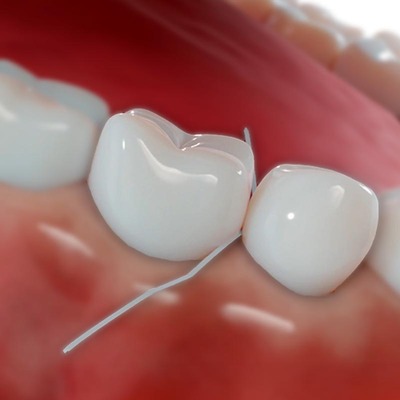Brushing twice a day is the first step in keeping your smile healthy. But for a comprehensive clean, it’s important to also remove the cavity-causing bacteria between teeth by incorporating flossing into your daily oral health routine.
When done correctly, flossing can:
Remove daily buildup between teeth that your toothbrush can’t reach.
Reduce your cavity risk, as untreated tooth decay will erode tooth enamel.
Prevent gum disease by removing the plaque at your gumline that can lead to gingivitis, and more severe, periodontal disease.
Improve bad breath caused by poor dental hygiene.
Failing to adequately clean between teeth can contribute to gum disease, cavities, and chronic oral health issues that can spread throughout the body. However, flossing is most effective when done with the proper technique.
When using traditional floss:
- Step 1 - Measure a string of floss approximately 18 inches in length.
- Step 2 - Wrap the floss around your middle fingers and firmly grasp the floss with your index fingers and thumbs so a comfortable length of usable floss is exposed.
- Step 3 - Gently glide the floss between your teeth. Using too much pressure can be damaging to your gums.
- Step 4 - Curve the floss in a “C” shape around the tooth, down below the gumline and back.
- Step 5 - Now clean the opposing tooth, below the gumline and back.
- Step 6 - Continue to clean both sides of each tooth. Be sure to use a clean section of floss to avoid spreading bacteria to other areas of the mouth.

When using a water flosser:
Water flossers use a steady stream of water pressure to remove plaque between teeth and at the gumline. They are a great option for people who have difficulty using traditional floss.
- Step 1 - Adjust the water pressure to a low-to-medium setting.
- Step 2 - Fill the water reservoir with lukewarm water and secure the tip or nozzle that best suits your needs. Some reservoirs can also be filled with your preferred mouthrise. Speak with your hygienist for more information.
- Step 3 - Holding the flosser at a 90-degree angle to your gumline, turn the flosser on. Move the tip slowly and systemically across all teeth.
Consistency and thoroughness in cleaning between your teeth, whether using traditional floss or a water flosser, plays a vital role in preserving excellent oral health! For personalized recommendations, speak to your dentist or hygienist about the best options to keep your smile healthy.




